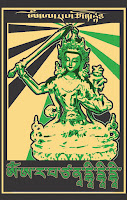Chokan had a very beautiful daughter named Seijo. He also had a handsome young cousin named Ochu. Joking. he would often comment that they would make a fine married couple. Actually, he planned to give his daughter's hand in marriage to another man. But young Seijo and Ochu took him seriously: they fell in love and thought themselves engaged. One dav Chokan announced Seijo's betrothal to the other man. In rage and despair, Ochu left by boat. After several days journey, much to his astonishment and joy he discovered that Seijo was on the boat with him! They went to a nearby city where they lived for several years and had two children. But Seijo could not forget her father: so Ochu decided to go back with her and ask the father's forgiveness and blessing. When they arrived, Ochu went to the father’s house. He humbly apologized to the father for taking his daughter away and asked forgiveness for them both. “What is the meaning of all this madness?” the father exclaimed. Then he related that after Ochu had left, many years ago. his daughter Seijo had fallen ill and had been comatose in bed since. Ochu assured him that he was mistaken, and, in proof, he brought Sejjo from the boat. When she entered, the Seijo lying in the bed rose to meet her and the two became one. Zen Master Goso, observed that Seijo had two souls. One always sick at home in bed and the other in the city, a married woman with two children. Which was the true soul?”
COMMENT: When one attains enlightenment, one transcends duality and is able to understand the truth of all things. The truth cannot be divided or dichotomized. Illusion and reality are only relative. There is no so-called reality without illusion. The new exists only in relation to the old. As for east and west, there are no such things. “To be” or “not to be” is not much of a problem. Life and death are different phases of one thing. Enjoy spring; enjoy summer. Enjoy, also, fall and winter! Truth is one; truth is many.
MY COMMENT: I have noticed in my life that everything is really the same, not in a bad or boring way. Good and bad are opposite ends of one state. Happy and sad are both simply emotions. Everything is everything.














